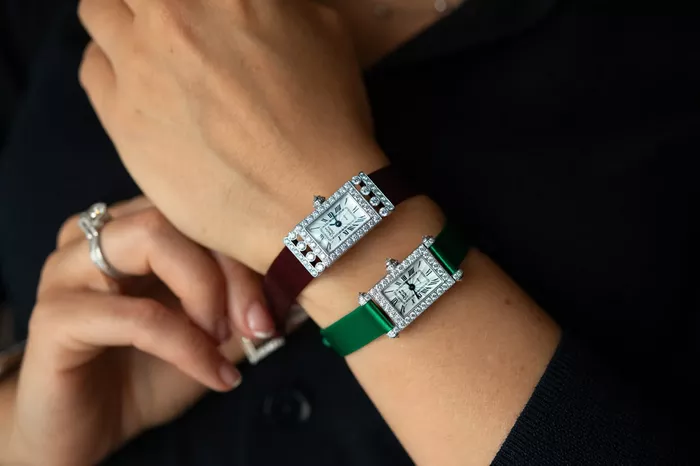The opulent streets of Paris’s Place Vendôme are a mecca for luxury shoppers, adorned with iconic jewelry and watch boutiques from renowned global brands. In this elite company, Charles Oudin, nestled in a grand 18th-century building for a quarter-century, maintains a discreet profile. Its elegant showroom, reminiscent of a Parisian apartment, resides upstairs, accessed through a quiet courtyard entry, and operates exclusively by appointment.
“We are,” asserts Claire Berthet, a company director, “welcoming guests as friends in a Parisian apartment.”
Charles Oudin (pronounced Sharl Ooh-dahn), founded in 1797, deliberately distinguishes itself from its illustrious neighbors with its secluded location. “It’s the right way for Charles Oudin,” Ms. Berthet adds. “In such a fiercely competitive world, we cannot emulate the industry leaders. We must chart our own course.”
The brand’s collection of timepieces is equally unique, characterized by their delicate, elegant, and decidedly feminine designs. These watches often feature petite 24-millimeter dials adorned with diamonds and other precious gems. The straps, typically crafted from silk satin, come in vibrant shades like sunshine yellow and cobalt blue.
Charles Oudin’s styles, exemplified by the rectangular Curvex collection, harken back to tradition and classic aesthetics. Ms. Berthet explains, “We sought a more retro, nostalgic touch, a reflection of our heritage.”
The price range for Charles Oudin watches varies from €15,500 ($16,730) for a 20-millimeter 18-karat gold timepiece embellished with 1.6 carats of diamonds to €140,000 for a unique 18-karat gold watch, adorned with a staggering 26 carats of assorted precious stones on both the case and bracelet. The average price of the brand’s offerings hovers around €25,000. (Notably, the brand often quotes prices without France’s 20 percent value-added tax, as the majority of its customers are international, and these purchases qualify for exemption.)
Powering these exquisite timepieces are quartz movements sourced from Swiss brand ETA, although upon request, they can be equipped with automatic Frédéric Piguet movements, also of Swiss origin.
Charles Oudin’s watches primarily incorporate French components and are meticulously crafted at the family’s watch manufacturing company in the Jura, an area bordering Switzerland and steeped in centuries of horological tradition.
“We take immense pride in crafting French horology,” Ms. Berthet affirms. “While we could have chosen to become Swiss, we remain steadfastly committed to our French heritage, continuing to produce our watches in France.”
This heritage traces back to Jean-Charles Oudin, a revered 18th-century French watchmaker known as Charles, who apprenticed under the legendary Abraham-Louis Breguet. In 1797, he introduced his eponymous brand in Paris, attracting luminaries like Napoleon, Josephine, and Queen Victoria as clientele. (By 1857, the brand, then known as Oudin-Charpentier, was owned by another watchmaker, Amédée Charpentier.) Despite its illustrious history, the brand faded into obscurity in the late 1920s.
Today, few outside the realms of watch history and industry insiders recognize the Charles Oudin brand.
“The name Charles Oudin may not ring a bell because they were fashion followers, not innovators,” remarks Rory McEvoy, executive director of the National Association of Watch & Clock Collectors. “They lacked a strong brand identity during that era; there’s no immediate recognition of an Oudin timepiece.”
In the 1990s, Camille Berthet, father of Claire Berthet, operated as an antique watch dealer, specializing in timepieces from the 17th to 19th centuries. When a client acquired his entire collection, except for the Oudin pieces, he made the bold decision to purchase the dormant brand’s name in 1998. Camille Berthet represents the fourth generation in a family deeply entrenched in the watch industry. Their Jura-based watch factory manufactures cases for several watch companies, including Charles Oudin.
Camille Berthet has transformed the revived Charles Oudin into a family enterprise: Claire Berthet oversees the business’s commercial aspect, while her younger sister, Carole Berthet, manages production. In a charming display of family unity, he occasionally brings Claire Berthet’s two young children to the Place Vendôme atelier for visits.
Recently, the brand has incrementally expanded its distribution beyond France.
Last year, Net-a-Porter introduced select pieces from the collection.
In February, Charles Oudin held a month-long pop-up event at Bergdorf Goodman in New York City, followed by a presence at the VIA Riyadh mall in Saudi Arabia in May.
In the coming months, it plans to participate in several Middle East trade shows, including the Jewelry Arabia show scheduled for November 14-18 in Bahrain.
While the company keeps its sales figures confidential, Ms. Berthet discloses that their 2022 sales doubled compared to the previous year. “We are a niche brand,” she acknowledges. “We’re certainly not in the league of LVMH or Richemont.”
Nevertheless, Charles Oudin, with its focus on watches tailored for women and its preference for straightforward movements, may not appeal to all collectors. In the thriving resale market, the brand is conspicuously absent from platforms like Chrono24 and Hodinkee.
In 2020, Sotheby’s Hong Kong auctioned a Charles Oudin 18-karat white gold, diamond, and pink sapphire watch from approximately 2015 for 27,500 Hong Kong dollars ($3,505) — a substantial discount compared to the price of a similar new model, which retails for over ten times as much.
“They’re beautifully designed, but they lack complicated features,” observes Daryn Schnipper, chairman of Sotheby’s International Watch Division. “It’s essentially about the diamonds.”
Nonetheless, Charles Oudin has no intentions of deviating from its chosen path.
“Our current collection, like our history, embodies classic design with rich decorative elements,” Ms. Berthet declares. “That is the essence of who we are, and we remain unwavering in our commitment to it.”

